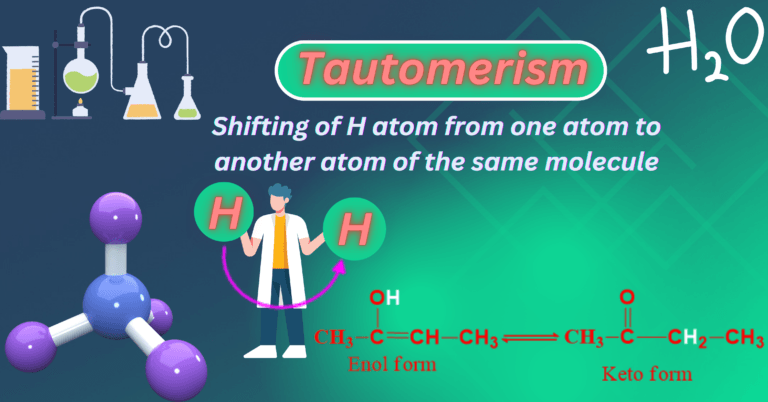Aromaticity rules in chemistry are a very fascinating concept that follows Huckle’s rule. The molecule that shows aromatic character must possess a planar, cyclic structure with a p-electron system. this system contains 4n+2π electrons.
[ez-toc]
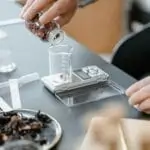
Aromaticity:
The term aromaticity in chemistry tells us the stability and specific properties of many cyclic compounds having alternated double bonds. In aromaticity rule structure must possess the following characteristics:
◊The structure should be cyclic.
◊It should be planar.
◊It should contain π electrons.
◊Must follow Huckle’s rule (4n+2), where n is integers.
For Example:
1-Naphthalene
In Naphthalene having molecular formula is (C10H8), aromaticity calculated as follows:
Naphthalene contains a Total of 10π electrons. Now putting the value of “n” indicates whether naphthalene is aromatic or not.
4n+2= 4(2) +2=8+2=10πelectrons
Here Huckle’s rule is followed, hence, we say that naphthalene is an aromatic compound.

2-Pyridine
Pyridine has molecular formula (C5H5N). It contains a total of 6 electrons in an aromatic structure. Now putting the value of “n” indicates whether pyridine is aromatic or not.
4n+2 = 4(1) +2 = 6πelectrons
Here Huckle’s rule is satisfied, hence, we say that pyridine is an aromatic compound.

Anti-aromaticity
Anti-aromaticity is defined as a molecule having a planar ring containing atoms with alternating double or single π electrons (Conjugated π electrons) that must satisfy the standard of aromaticity but show unstable alternatively stability. This stability character proves that anti-aromatic compounds are less stable as compared to aromatic compounds. The following characteristics must be possessed by a compound that is anti-aromatic.
◊Compounds follow the 4n electrons rule. Here “n” is an integer.
◊Compounds must be less stable than aromatic as well as non-aromatic compounds.
◊It may or may not be planar in structure.
◊It must contain an odd number of electrons in the ring.
For Example:
1-Cyclobutadiene:
It has molecular formula C4H8. It contains 4λ electrons. The calculation formula is 4nλ electrons where n is 1. Hence cyclobutadiene contains 4λ electrons.
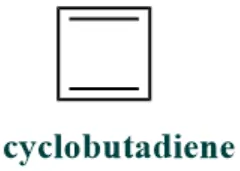
2-Cyclopentadienyl anion (C₅H₅⁻):
Here number of π electrons is 6 (extra electrons here indicate the presence of an anion)
According to Huckel’s Rule, for a planar mono-cyclic compound to be anti-aromatic, it must have 4n + 2 π electrons, where n is an integer. Here, n = 1, so 4n + 2 = 6, which matches the number of π electrons in the cyclopentadienyl anion.
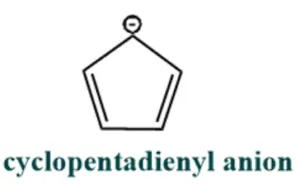
Both of these compounds are considered anti-aromatic according to Huckel’s rule, which predicts their instability due to the presence of a fully conjugated cyclic system with the appropriate number of π electrons.
Non-Aromaticity
The compounds are said to be non-aromatic which do not have a continuous overlapping ring of p-orbitals can’t be aromatic or anti-aromatic.
For Example:
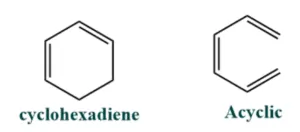
In these structures, firstly in the case of cyclohexadiene, there is no conjugation, which indicates clearly that the structure must be non-aromatic. In the case of an open ring structure or acyclic, no planarity shows that the structure is not a planner and it must be non-aromatic.
Stability Order:
Aromatic compounds > Non-Aromatic compounds > Anti-Aromatic compounds
FAQ
What kind of behavior is shown by a given structure aromatic, non-aromatic, or anti-aromatic? Give a suitable reason.
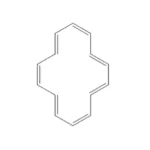 Answer: The given structure indicates that it follows all properties that are found in the aromatic compound, as it is planar, cyclic, overlapping λ electrons, and also follows Huckle’s rule
Answer: The given structure indicates that it follows all properties that are found in the aromatic compound, as it is planar, cyclic, overlapping λ electrons, and also follows Huckle’s rule
(4n+2 λelectrons).
4n+2 = 4(4)+2= 18
Hence, all such properties clear that that structure is aromatic.
This structure is anti-aromatic. Give reason.
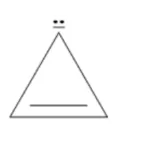
Answer: In this structure, although a lone pair of electrons is present which is considered part of the ring shows its planarity. This structure does not completely fulfill the characteristics of aromatic compounds instead it is cyclic because it does not follow Huckle’s rules.
4n λelectrons = 4(2)= 8λelectrons
Hence; it indicates this structure is anti-aromatic, not aromatic.
Indicate the anti-aromatic, non-aromatic, and aromatic character from the following structures.
 Answer:
Answer:
A) Structure which is indicated by (a) shows it is aromatic. The reason is that it has a lone pair of electrons which must consider the part of the ring. Hence it follows all properties of aromatic character including it has cyclic, planar structure and structure also follows Huckle’s rule.
B) Structure in block (b) shows it is anti-aromatic because here no huckle’s rule is followed.
C) Structure in block (c) shows no planarity, no conjugation, and no huckle rule is followed here. Which indicates it is a non-aromatic structure.
